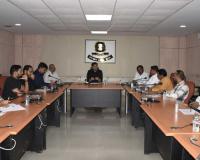Flooding in Vijayawada Leads to Extensive Damage to Surat Textile Businesses
Recent floods in Vijayawada, Andhra Pradesh, have caused significant losses for textile merchants from Surat, with estimated damages around INR 50 crores.

Last week's severe flooding in Vijayawada, Andhra Pradesh, has had a profound impact on the textile industry, particularly affecting businesses from Surat. Reports suggest that Surat-based textile merchants are facing potential losses amounting to approximately INR 50 crores due to waterlogged warehouses.
Surat’s textile businesses frequently ship goods to Vijayawada via 8 to 10 transportation services. From September 1 to 4, about 20,000 parcels were submerged in floodwaters reaching 5 to 7 feet inside the Vijayawada transport warehouses. The overall damage from the floods is feared to total up to INR 150 crores across various sectors.
Yuvraj Desale, the head of Surat Textile Goods Transport Association, shared that besides the transport warehouses, many large-scale traders also store their shipments in private warehouses, all of which have been devastated by the floods. He noted that significant consignments, including blankets from Panipat and men’s shirting and dhotis from Pali-Bhilwara in Rajasthan, were also affected, impacting numerous businesses throughout India.
Neeraj Singh from RK Transport highlighted the focus on insurance: "The Transport Association always advises traders to insure their goods. If the merchants had insured their cargo, the losses could have been mitigated." He expressed concern over the ability of some transporters to compensate for the losses, sharing an anecdote about a dispute where one transporter refused to pay their share, leading to out-of-pocket payments on his part.
Singh strongly urged Surat traders to insure every parcel they ship to safeguard against such calamities, ensuring compensation through insurance in times of disaster. This disaster underscores the vulnerability of the textile industry to natural calamities and the critical importance of adequate risk management measures.






